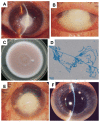Clinical experience treating Paecilomyces lilacinus keratitis in four patients
- PMID: 22791978
- PMCID: PMC3392915
- DOI: 10.2147/OPTH.S29379
Clinical experience treating Paecilomyces lilacinus keratitis in four patients
Abstract
Background: Paecilomyces lilacinus is a saprobic fungus that occasionally causes keratitis in infected patients. Voriconazole, a triazole antifungal agent, is often administered to treat P. lilacinus keratitis, because it is resistant to many antifungal agents. However, some patients may not require voriconazole. Here, we report our experience of treating this infection and compare outcomes between patients treated with or without voriconazole.
Subjects: We retrospectively reviewed four cases of infectious keratitis caused by P. lilacinus and compared treatment course and outcomes among the four cases.
Observations: P. lilacinus was isolated from corneal cultures in all four cases. Three cases developed corneal perforation and underwent keratoplasty. Voriconazole was given in two cases with severe and refractory infection. Both required long-term treatment despite the effectiveness of voriconazole. They also had a medical history of diabetes and corticosteroid therapy. In two cases that were not treated with voriconazole, the eye conditions improved with a short treatment period (2-3 weeks). Neither of these cases had a medical history of diabetes, nor had they used corticosteroids.
Conclusion: Although voriconazole is the most useful antifungal agent for treating P. lilacinus keratitis, this infection can be resolved by other treatments. Voriconazole should be offered to patients with diabetes and/or prior corticosteroid use.
Keywords: Paecilomyces lilacinus; corticosteroids; diabetes; voriconazole.
Figures




Similar articles
-
Treatment of resistant Paecilomyces lilacinus keratitis with topical voriconazole and oral itraconazole: a rare case report from Somalia.Ann Med Surg (Lond). 2024 Mar 6;86(4):2172-2175. doi: 10.1097/MS9.0000000000001925. eCollection 2024 Apr. Ann Med Surg (Lond). 2024. PMID: 38576982 Free PMC article.
-
The use of voriconazole in the management of post-penetrating keratoplasty Paecilomyces keratitis.J Ocul Pharmacol Ther. 2009 Apr;25(2):175-7. doi: 10.1089/jop.2008.0096. J Ocul Pharmacol Ther. 2009. PMID: 19284327
-
Topical voriconazole as a novel treatment for fungal keratitis.Antimicrob Agents Chemother. 2006 Jan;50(1):262-8. doi: 10.1128/AAC.50.1.262-268.2006. Antimicrob Agents Chemother. 2006. PMID: 16377696 Free PMC article.
-
Use of voriconazole for the treatment of Paecilomyces lilacinus cutaneous infections: case presentation and review of published literature.Mycopathologia. 2013 Apr;175(3-4):345-9. doi: 10.1007/s11046-012-9610-3. Epub 2013 Jan 20. Mycopathologia. 2013. PMID: 23334554 Review.
-
Paecilomyces lilacinus endophthalmitis with secondary keratitis: a case report and literature review.Arch Ophthalmol. 1997 Oct;115(10):1320-4. doi: 10.1001/archopht.1997.01100160490021. Arch Ophthalmol. 1997. PMID: 9338682 Review.
Cited by
-
Topical voriconazole therapy of Purpureocillium lilacinum keratitis that occurred in disposable soft contact lens wearers.Int Ophthalmol. 2014 Oct;34(5):1159-63. doi: 10.1007/s10792-014-9965-1. Epub 2014 Jun 29. Int Ophthalmol. 2014. PMID: 24974133
-
First Report of a Case of Ocular Infection Caused by Purpureocillium lilacinum in Poland.Pathogens. 2021 Aug 18;10(8):1046. doi: 10.3390/pathogens10081046. Pathogens. 2021. PMID: 34451510 Free PMC article.
-
Paecilomyces formosus Infection in an Adult Patient with Undiagnosed Chronic Granulomatous Disease.J Clin Immunol. 2017 May;37(4):342-346. doi: 10.1007/s10875-017-0395-5. Epub 2017 Apr 20. J Clin Immunol. 2017. PMID: 28429104 No abstract available.
-
Recalcitrant Paecilomyces keratitis.BMJ Case Rep. 2019 Apr 24;12(4):e229226. doi: 10.1136/bcr-2019-229226. BMJ Case Rep. 2019. PMID: 31023737 Free PMC article.
-
Postoperative keratitis due to Paecilomyces: a rare pediatric case.Pan Afr Med J. 2016 Aug 18;24:317. doi: 10.11604/pamj.2016.24.317.9772. eCollection 2016. Pan Afr Med J. 2016. PMID: 28154672 Free PMC article.
References
-
- Ford JG, Agee S, Greehaw ST. Successful medical treatment of a case of Paecilomyces lilacinus keratitis. Cornea. 2008;27(9):1077–1079. - PubMed
-
- Deng SX, Kamal KM, Hollander DA. The use of voriconazole in the management of post-penetrating keratoplasty Paecilomyces keratitis. J Ocul Pharmacol Ther. 2009;25(2):175–177. - PubMed
-
- Yuan X, Wilhelmus KR, Matoba AY, Alexandrakis G, Miller D, Huang AJW. Pathogenesis and outcome of Paecilomyces keratitis. Am J Ophthalmol. 2009;147(4):691–696. - PubMed
-
- Wu PC, Lai CH, Tan HY, Ma DHK, Hsiao CH. The successful medical treatment of a case of Paecilomyces lilacinus keratitis. Cornea. 2010;29(3):357–358. - PubMed
-
- Starr MB. Paecilomyces keratitis: two case reports in extended wear contact lens wearers. CLAO J. 1987;13(2):95–101. - PubMed
Publication types
LinkOut - more resources
Full Text Sources

